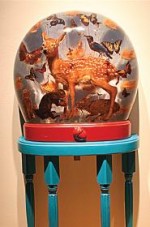Alumni artists prove anything but atrocious

At first glance, Everyday Atrocities looks like a terrorist organization with a taxidermy hobby. However, it is actually a faculty focus exhibition in the Contemporary Art Museum.
From the look of Gregory Green’s pieces there is confusion as to whether he promotes or opposes violence. This is because all his pieces models of explosives. Green grew up in Europe in the height of the Cold War. His work, he said, is influenced by this time in his life where he and everyone around him lived in constant fear.
Most of his pieces are not displayed like traditional art pieces. A model pipe bomb lies on the floor in the corner with barely any lighting. A Bible with an explosive inside sits prominently in the center of the room. Green explained that we typically think of terrorism groups strictly as Islamic and Muslim, but Christian extremist groups actually commit just as many acts. Green said his intention was for the pieces to be provocative and somewhat scary. As long as no one is truly frightened by them, he said, his pieces are still legal under the Patriot Act.
One of Julie Weitz’s pieces is a series of four paintings of hooded figures, one of which is of a hooded Ku Klux Klan figure. Her pieces aren’t just of terrorist figures – they include groups that wear headscarves for religious purposes. Weitz said the inspiration for her pieces came from the constant visual imagery we get in the media of people in headscarves. Her fascination for the person behind the scarf inspired her to paint these pictures. Her paintings make you wonder the same thing – especially the painting of a red-hooded figure. You can just barely see the eyes, making you remember there is a human being underneath it.
John Byrd’s pieces don’t seem to fit with the other artists’ works. His pieces feature taxidermy cast in plastic resin. Byrd said he was inspired by his constant feeling of being an observer and a plastic paperweight with a scorpion inside, a gift a neighbor gave him when he was a child.
After hearing that he is an animal lover and is for animal rights, I was surprised that there were real animals inside his pieces. However, Byrd said he tries not to be directly responsible for the animals’ deaths. In one piece he uses kittens, which – like thousands of cats – were euthanized at an animal shelter.
Aside from this, his two large pieces were beautiful. One was a snow globe featuring a fawn and ducks. He said Ripley’s Believe It Or Not! almost purchased the piece until they discovered that it was a piece of art, and not an amazing phenomenon.
As a whole, the exhibit was very thought-provoking. It was a nice change from the traditional paintings and sculptures you usually see at a museum.
The exhibit, which runs through Feb. 23, can be seen Monday through Friday from 10 a.m. to 5 p.m., and Saturdays from 1 to 4 p.m.






